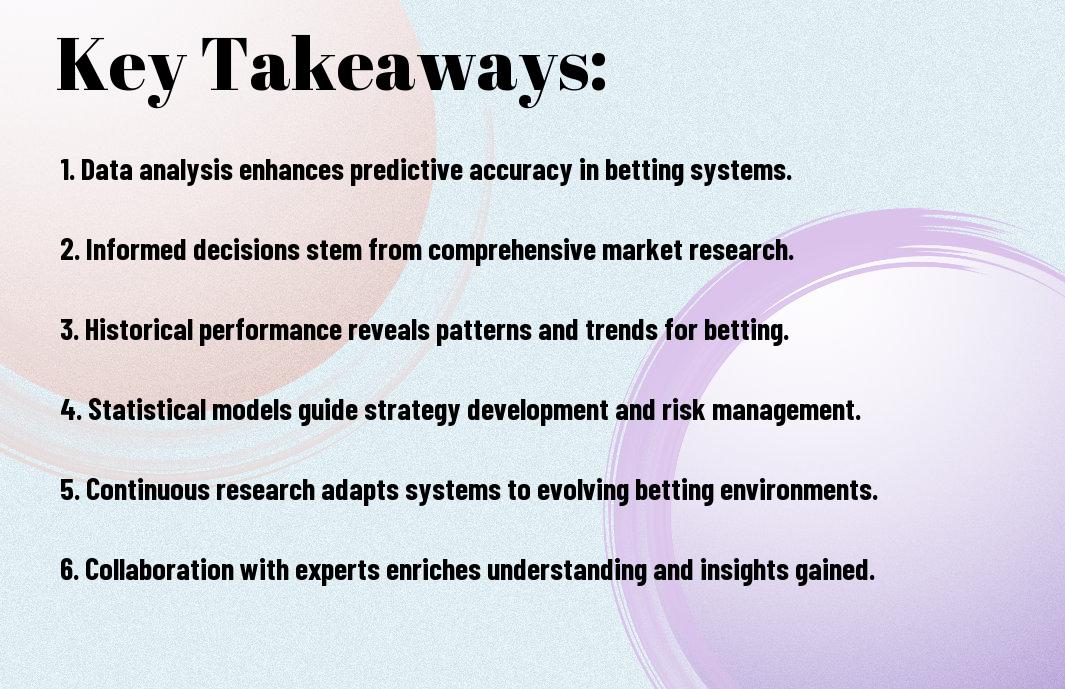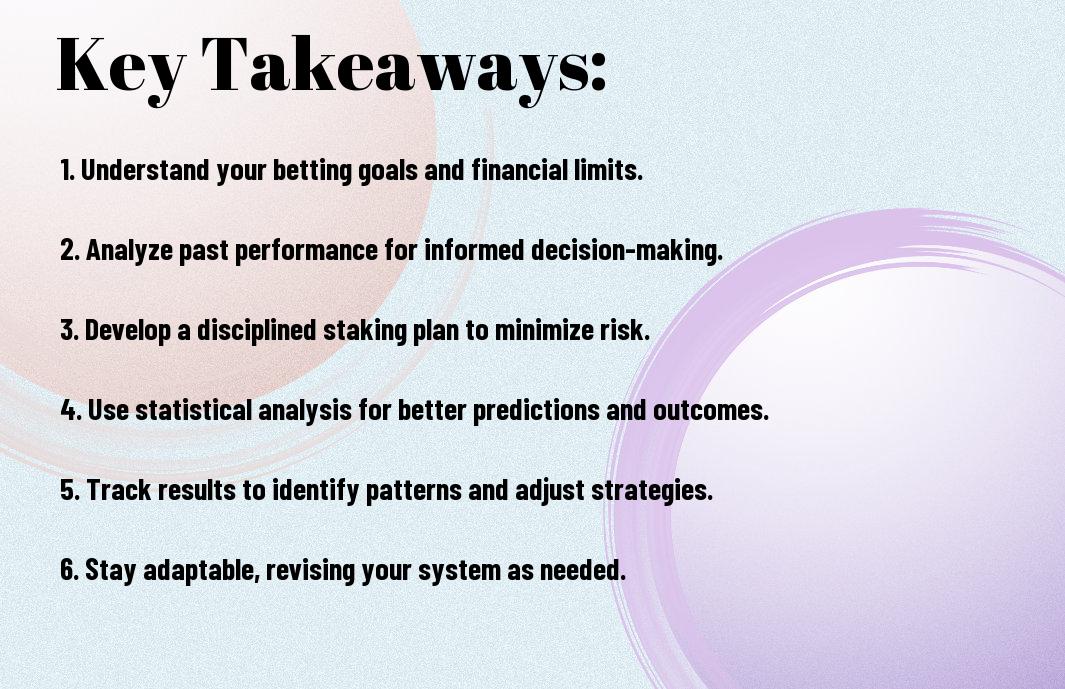As you research into the world of betting, you’ll soon realize that having a personal betting system is imperative to making informed decisions. You need a strategy that aligns with your goals and risk tolerance. Your approach will depend on your betting style, preferences, and the sports you bet on. By developing a personalized system, you’ll be able to make more accurate predictions and increase your chances of winning, allowing you to take control of your betting experience and make the most of your investments.

Key Takeaways:
- Define your betting goals and risk tolerance to determine the type of betting system that suits you best, whether it’s focused on high-risk high-reward or low-risk steady gains.
- Conduct thorough research and analysis of the sports, teams, or events you want to bet on, including statistics, trends, and expert opinions to make informed decisions.
- Develop a unique betting strategy based on your research, such as value betting, arbitrage, or hedging, and continuously evaluate and adjust it as needed.
- Set a budget and stick to it, avoiding the temptation to chase losses or bet more than you can afford, and prioritize responsible betting practices to maintain a healthy relationship with gambling.
- Keep track of your betting history and performance, using tools like spreadsheets or betting journals to identify areas for improvement and refine your system over time.
The Psychology of Betting
A key aspect of developing a personal betting system is understanding the psychology behind your betting decisions, which can be influenced by various factors, including your emotions and risk tolerance, learn more about How to Develop a Long-Term Sports Betting Strategy? to improve your chances of success.
Risk Assessment
Affording yourself time to evaluate your risk tolerance is crucial, as it will help you make informed decisions and avoid reckless bets that can deplete your bankroll quickly, you should assess your financial situation and set limits for yourself.
Emotional Control
Besides being aware of your emotions, you need to learn how to manage them effectively, as emotions can cloud your judgment and lead to impulsive decisions, you must find ways to stay calm and composed, even in the face of a losing streak.
This ability to control your emotions will serve you well in the long run, as it will allow you to make rational decisions and stick to your betting strategy, even when things are not going your way, you will be able to analyze your mistakes and adjust your approach accordingly, which is crucial for developing a successful personal betting system.
Core Elements of a Betting System
Some key components make up a solid betting system, including bankroll management, stake sizing, and a well-defined strategy. You will need to consider these elements to develop a system that works for you.
Bankroll Management
For effective betting, you must manage your bankroll carefully, setting aside a specific amount for betting and sticking to it, ensuring you can withstand losses and stay in the game.
Stake Sizing
One of the most important aspects of your betting system is determining the right stake size, as it directly impacts your potential winnings and losses, and you should adjust it according to your bankroll and risk tolerance.
Elements of stake sizing, such as the Kelly Criterion or fixed fractional betting, can help you optimize your bets, and you can choose the method that best suits your betting style and goals, allowing you to maximize your returns while minimizing your risk, and you will be able to refine your approach as you gain more experience and gather more data on your betting performance.
Data Analysis Methods
To develop a personal betting system, you need to analyze data effectively. This involves using various methods to understand patterns and trends in the data, which will help you make informed decisions.
Statistical Approaches
For instance, you can use statistical models to identify correlations and regressions in the data, allowing you to predict future outcomes and make more accurate bets.
Historical Performance Review
After collecting data, you should review your historical performance to identify areas of improvement and refine your betting strategy, which will help you to make better decisions in the future.
Even when you have a solid understanding of statistical approaches, reviewing your historical performance is imperative to understand what works and what doesn’t in your betting system, and you can use this information to adjust your strategy and improve your chances of winning.

Record Keeping
Many bettors overlook the importance of record keeping, but it is imperative to developing a personal betting system. You need to track your bets, including the type of bet, stake, and outcome, to identify patterns and areas for improvement.
Documentation Systems
Besides using a spreadsheet or a dedicated betting app, you can also use a notebook to log your bets, allowing you to analyze your performance and make informed decisions about your betting strategy. You will be able to see what works for you and what doesn’t.
Performance Tracking
Between analyzing your wins and losses, you will gain valuable insights into your betting habits and be able to adjust your strategy accordingly. You can use this information to refine your approach and increase your chances of success.
Understanding your performance is key to improving your betting system. You can track metrics such as your win-loss ratio, average stake, and return on investment to get a clear picture of your betting performance. By regularly reviewing your performance, you can identify areas where you need to improve and make adjustments to your strategy to achieve better results.
Risk Management Strategies
Despite the excitement of betting, you must prioritize risk management to protect your bankroll. Effective strategies will help you navigate potential losses and maximize gains, ensuring a sustainable betting experience.
Stop-Loss Limits
Along with setting boundaries, you should establish stop-loss limits to cap potential losses, preventing significant damage to your bankroll when a bet doesn’t go in your favor.
Profit Targets
Beneath your overall betting goals, you should define profit targets, which will help you stay focused on achievable objectives and make informed decisions about when to withdraw your winnings.
It is important to set realistic profit targets, as this will help you avoid getting caught up in the thrill of a winning streak and making impulsive decisions that could jeopardize your gains, allowing you to maintain control over your betting activities and make the most of your personal betting system.
System Testing
Once again, you’ll need to put your personal betting system to the test, evaluating its performance and making adjustments as needed. This step is vital to ensuring your system is effective and profitable in the long run.
Paper Trading
To begin testing, you’ll start by using your system to make simulated bets, tracking the outcomes and analyzing the results to identify areas for improvement.
Real-Money Trial Runs
Behind the scenes of paper trading, you’ll eventually need to test your system with real-money bets, starting with small stakes to minimize potential losses.
A key aspect of real-money trial runs is to monitor your system’s performance closely, taking note of any inconsistencies or unexpected outcomes, and making adjustments to your strategy as you continue to test and refine your approach, allowing you to make informed decisions and optimize your betting system for maximum returns.
Summing up
As a reminder, developing a personal betting system takes time and effort, but with persistence, you can create a strategy that works for you. You will refine your approach as you gain experience, and your betting system will evolve to suit your needs. By following the tips and tricks outlined, you can increase your chances of success and make informed decisions, allowing you to enjoy your betting experience and potentially achieve your goals. You are now equipped to start building your own personalized betting system.
FAQ
Q: What is the first step in developing a personal betting system?
A: The first step in developing a personal betting system is to define your betting goals and risk tolerance. This involves determining what you want to achieve through betting, whether it’s to make a profit, have fun, or a combination of both. You should also assess your financial situation and decide how much you can afford to lose. Setting clear goals and understanding your risk tolerance will help you create a system that suits your needs and personality.
Q: How do I analyze data and trends to inform my betting decisions?
A: Analyzing data and trends is a key component of developing a successful personal betting system. Start by gathering historical data on the sports or events you’re interested in betting on. Look for patterns and trends, such as team performance, player injuries, and weather conditions. You can use statistical models, machine learning algorithms, or simply observe past results to identify trends. It’s also crucial to stay up-to-date with the latest news, injuries, and other factors that may impact the outcome of events. By combining data analysis with your own knowledge and experience, you can make informed betting decisions and increase your chances of winning.
Q: What are some common mistakes to avoid when developing and using a personal betting system?
A: One common mistake is to chase losses by increasing bet sizes or making impulsive decisions. This can lead to a significant depletion of your bankroll and undermine your overall strategy. Another mistake is to be too rigid or inflexible with your system, failing to adapt to changing circumstances or new information. It’s also important to avoid overbetting or betting on too many events, as this can increase your exposure to risk. Additionally, be cautious of biases and emotions, such as favoring a particular team or player, and make sure to continuously evaluate and refine your system to ensure it remains effective and profitable.













